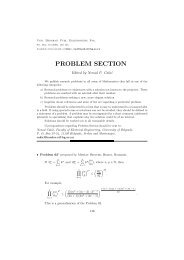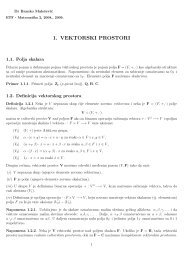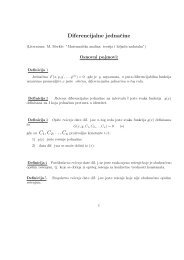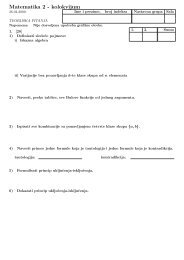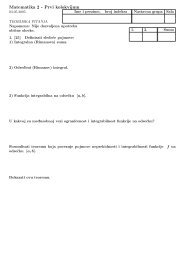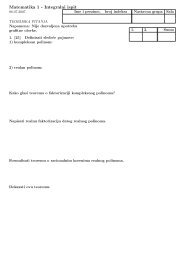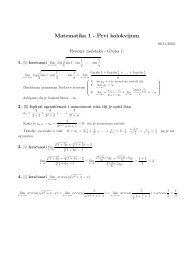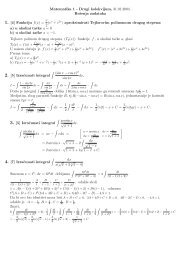MURRAY SEYMOUR KLAMKIN - Matematika
MURRAY SEYMOUR KLAMKIN - Matematika
MURRAY SEYMOUR KLAMKIN - Matematika
You also want an ePaper? Increase the reach of your titles
YUMPU automatically turns print PDFs into web optimized ePapers that Google loves.
Univ. Beograd. Publ. Elektrotehn. Fak.Ser. Mat. 16 (2005), 142-145.Available electronically at http: //pefmath.etf.bg.ac.yuMEMORIAL CELEBRATION OF THE LIFE OF<strong>MURRAY</strong> <strong>SEYMOUR</strong> <strong>KLAMKIN</strong>(1921-2004)Andy LiuLet me first make it clear that this is not a eulogy. By my definition, a eulogyis an attempt to make the life of the departed sound much better than it was. In thepresent case, it is not only unnecessary, it is actually impossible. Murray SeymourKlamkin had a most productive and fulfilling life, divided between industry andacademia.Of the early part of his life, I knewlittle except that he was born in 1921in Brooklyn, New York, where his fatherowned a bakery. This apparently inducedin him his life-long fondness for bread.I read in his curriculum vita that hisundergraduate degree in Chemical Engineeringwas obtained in 1942 from CooperUnion’s School of Engineering. Duringthe war, he was attached to a chemicalwarfare unit stationed in Maryland, as hisyounger sister Mrs. Judith Horn informedme. In 1947, Murray obtained a Masterof Science degree from the Polytechnic Instituteof New York, and taught there until1957 when he joined AVCO’s Researchand Advanced Development Division.In 1962, Murray returned brieflyto academia as a professor at SUNY, Buffalo, and then became a visiting professorat the University of Minnesota. In 1965, he felt again the lure of industry and joinedFord Motor Company as the Principal Research Scientist, staying there until 1976.During all this time, Murray had been extremely active in the field of mathematicsproblem solving. His main contribution was serving as the editor of the problemsection of SIAM Review. He had a close working relation with the Mathemat-142
Memorial Celebration of the Life of Murray Seymour Klamkin (1921-2004) 143ical Association of America, partly arising from his involvement with the WilliamLowell Putnam Mathematics Competition.In 1972, the MAA started the USA Mathematical Olympiad, paving the wayfor the country’s entry into the International Mathematical Olympiad in 1974,hosted by what was still East Germany.Murray was unable to obtain from Ford release time to coach the team.Disappointed, he began to look elsewhere for an alternative career. This was whatbrought him to Canada, at first as a Professor of Applied Mathematics at theUniversity of Waterloo.However, it was not until the offer came from the University of Alberta thatmade up his mind to leave Ford. I did not know if Murray had been to Banff before,but he must have visited this tourist spot during the negotiation period, fell in lovewith the place and closed the deal.As Chair, Murray brought with him a management style from the privatesector. Apparently not everyone was happy with that, but he did light some firesunder several pairs of pants, and rekindled the research programs of the wearers.Murray had always been interested in Euclidean Geometry. He often toldme about his high school years when he and a friend would challenge each otherto perform various Euclidean constructions. Although the Chair had no teachingduties at the time, Murray took on a geometry class himself.At the same time, Murray began editing the Olympiad Corner in Crux Mathematicorum,a magazine then published privately by Professor Leo Sauve of Ottawa.It is now an official journal of the Canadian Mathematical Society. Murray alsointroduced the Freshmen and Undergraduate Mathematics Competitions in theDepartment.Geometry, mathematics competitions and Crux Mathematicorum were whatbrought me to Murray’s attention. At the time, I was a post-doctoral fellow seekingemployment, having just graduated from his Department. Thus I was ready to doanything, and it happened that my interests coincided with those of Murray. Iwas holding office hours for his geometry class, helping to run the Department’scompetitions and assisting him in his editorial duty.I remember being called into his office one day. He had just received a problemproposal for Crux Mathematicorum. ”Here is a nice problem,” he said, ”but theproposer’s solution is crappy. Come up with a nice solution, and I need it by Fridayafternoon!”As much as I liked problem-solving, I was not sure that I could produce resultsby an industrial schedule. Nevertheless, I found that I did respond to challenges,and although I was not able to satisfy him every time, I managed to do much betterthan if I was left on my own, especially after I had got over the initial culture shock.The late seventies were hard times for academics, with few openings in postsecondaryinstitutions. I was short-listed for every position offered by the Department,but always came just short. Eventually, I went elsewhere for a year as
144 Andy Liusabbatical replacement. Murray came over to interview me for a new position,pushed my appointment through the Hiring Committee and brought me back in1980.Murray had been the Deputy Leader for the USA National Team in the IMOsince 1975. In 1981, USA became the host of the event, held outside Europe forthe first time. Sam Greitzer, the usual Leader, became the chief organizer. Murraytook over as the Leader, and secured my appointment as his Deputy Leader.I stayed in that position for four year, and in 1982, made my first trip toEurope because the IMO was in Budapest. This was followed by IMO 1983 inParis, and IMO 1984 in Prague. I was overawed by the international assembly, butfound that they in turn were overawed by Murray’s presence. He was arguably themost well-known mathematics problem-solver in the whole world.We both retired from the IMO after 1984, even though I would later return toit. His term as Chair also expired in 1981. Thus our relationship became collegialand personal. He and his wife Irene had no children, but they were very fond ofcompany. I found myself a guest at their place at regular interval, and they visitedmy humble abode a few times.It was during this period that I saw a different side of Murray. Before, Ifound him very businesslike, his immense talent shining through his incisive insightand clinical efficiency. Now I found him a warm person with many diverse interest,including classical music, ballroom dancing, adventure novels, kung-fu movies andsports, in particular basketball.Although Murray had been highly successful in everything he attempted, hewill probably be remembered the most for his involvement in mathematics problemsolvingand competitions. He had authored or edited four problem books, and hadleft his mark in every major journal which had a problem section. He had receivedan Honorary Doctorate from the University of Waterloo and was a Fellow of theRoyal Society of Belgium. He had won numerous prizes, and had some named afterhim.Murray had enjoyed remarkably good health during his long life. It began todeteriorate in September 2000 when he underwent a by-pass operation. After hisrelease from the hospital, he continued to exert himself, walking up to his office onthe sixth floor, and skating in the West Edmonton Mall.His heart valve gave in November, fortunately while he was already in thehospital for physiotherapy. He was in coma for some time. One day, when I visitedhim, he was bleeding profusely from his aorta. The doctor indicated to me that hedid not expect Murray to last through the day.Somehow, the inner strength of Murray came through, and on my next visit,he was fully conscious. He told me to make arrangement for his eightieth birthdayparty, stating simply that he would be out of the hospital by that time. It was agood thing that I took his words seriously, for he was out of the hospital by thattime, ready to celebrate.
Memorial Celebration of the Life of Murray Seymour Klamkin (1921-2004) 145One of the last mathematical commitment he made was to edit the problemsection in the MAA’s new journal Math Horizons. During this difficult time, heasked me to serve with him as joint-editors. Later, he passed the column onto me,but his finger-prints were still all over the pages.Now I have to try to fill in his shoes without the benefit of his wisdom. Hispassing marks the end of an era in the world of mathematics competition andproblem-solving. He will be deeply missed.Department of Mathematical and Statistical Sciences,University of Alberta,632 Central Academic Building,Edmonton, AB T6G 2G1,CanadaE–mail: aliu@math.ualberta.ca


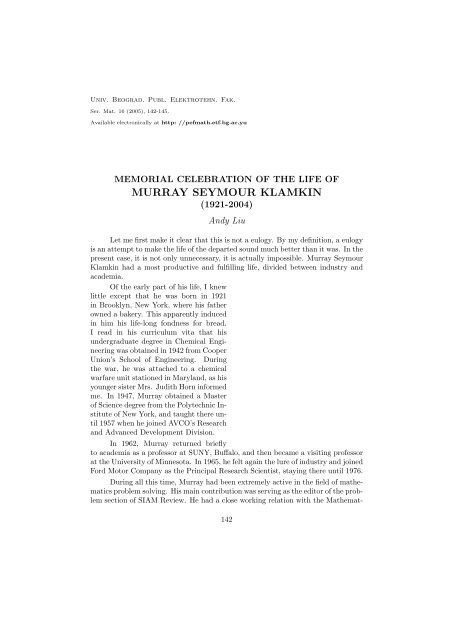
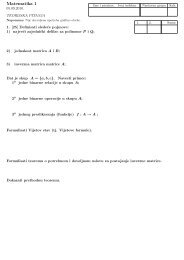
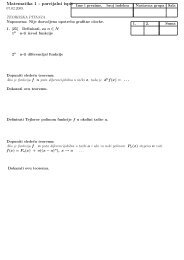

![Matematika 1 3. [7]](https://img.yumpu.com/49790285/1/184x260/matematika-1-3-7.jpg?quality=85)
